#comic: supergirl movie special (1985)
Text

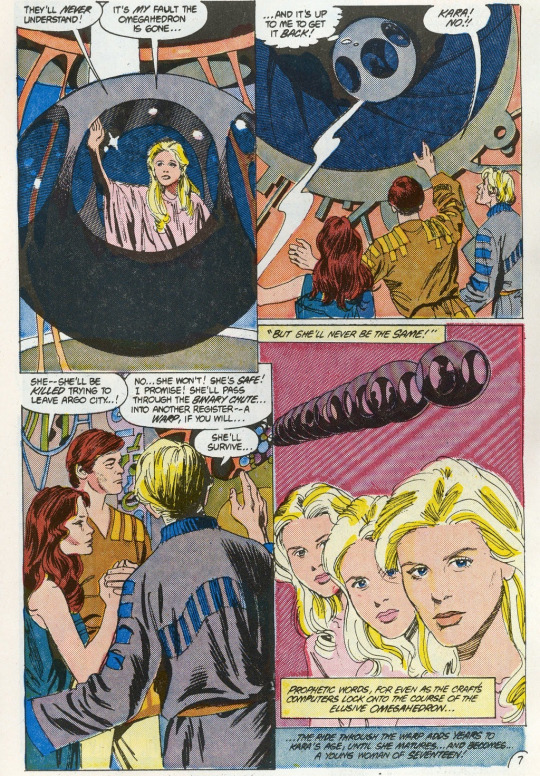


SUPERGIRL MOVIE SPECIAL (1985)
written by Joey Cavalieri
art by Gray Morrow
19 notes
·
View notes
Text
Supergirl Movie Special (1985) José Luis García-López & Dick Giordano Cover & Gray Morrow Pencils, Joey Cavalieri Story, 1st Appearance of Supergirl (Linda Lee) from Earth-789.
#SupergirlMovieSpecial (1985) #JoséLuisGarcíaLópez & #DickGiordano Cover & #GrayMorrow Pencils, #JoeyCavalieri Story, 1st Appearance of #Supergirl (#LindaLee) from #Earth789. The comic book adaptation of the feature film scripted by David Odell. SAVE ON SHIPPING COST - NOW AVAILABLE FOR LOCAL PICK UP IN DELTONA, FLORIDA https://www.rarecomicbooks.fashionablewebs.com/Supergirl%20Movie%20Special.html#1 #VertigoComics #Vertigo #KeyComicBooks #DCComics #DCU #DCUniverse #KeyIssue #NerdyGifts
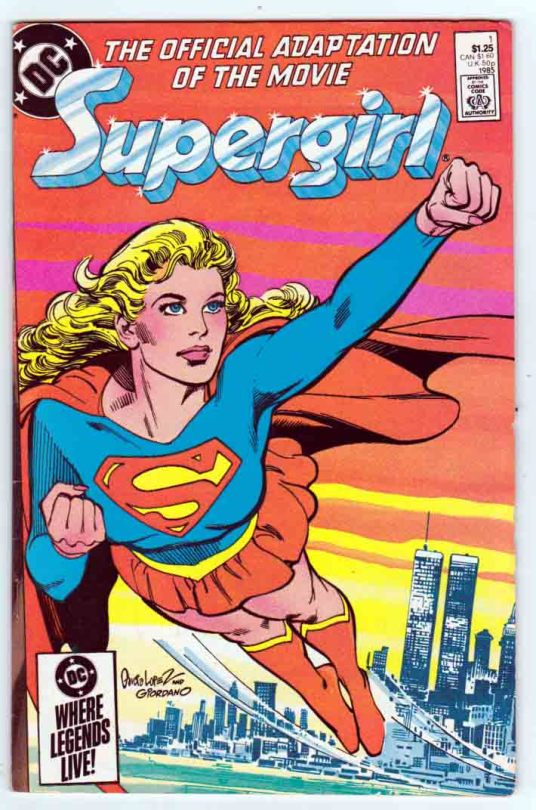
#Supergirl Movie Special (1985) José Luis García-López & Dick Giordano Cover & Gray Morrow Pencils#Joey Cavalieri Story#1st Appearance of Supergirl (Linda Lee) from Earth-789.#key comic books#dc comics#rare comic books#key comics#dc universe
0 notes
Note
Um Hi, So I'm super late to the party when it comes to shipping Brainy and Kara but I really enjoyed your writing and was hoping you could recommend some stuff if you don't mind, please? Even the actual comics if you know which have them romantically involved? Again, really loved your works and hope to see more. Thank you. :)
Hi!! Welcome to the ship! And aw, thanks, I'm glad you liked my writing! I'm sorry there isn't more of it - I'm really bad at finishing things. 😩
But hmm, okay, Karadox recs. I have a few things in mind. This is going to get kinda long, so I'm just gonna put the rest under a cut, I think...
Okay! If you're looking for fics, @cyclone-rachel has written a lot of great stuff for Kara and Brainy (mostly the CW versions). I'm sure Rachel can recommend some more fic writers, too.
If you're looking for comics, I'd suggest Supergirl Annual #2 (2010) as a nice (mostly) one-off comic that focuses on the beginning of their relationship. Also Supergirl (2005) #52, which is technically part of a larger "Last Stand of New Krypton" arc, but I suppose it can be read on its own, and it has a lot of great Karadox stuff.
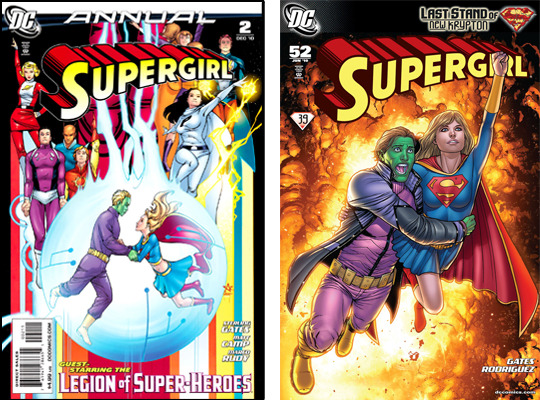
There are also some comics that you might not expect to have good Karadox content in them that actually do, such as the Legion of Super-Heroes/Bugs Bunny Special (2017) and the "Sugar & Spike" story from Legends of Tomorrow (2016) #6. You can also read the "House of Kent" arc in Action Comics (2016) #1022-#1028 if you want, because Kara and Brainy are both featured in most of those issues. They don't interact as much as I personally would've liked, but they have some nice moments, and there was definitely some romantic setup happening towards the end.
Supergirl & the Legion of Super-Heroes (2006) is another option, but be warned that Kara and Brainy are NOT romantically involved in that version of the Legion (Brainy was paired up with Dream Girl's ghost instead... it was a whole thing) so their dynamic isn't as good as it normally is. But they do at least interact a lot.
Honestly, the majority of Kara and Brainy's comic romance took place before Crisis on Infinite Earths (meaning pre-1985), and I haven't actually read most of those older comics yet, just bits and pieces here and there. Someone like @supergirltastic would be a much better person to ask for those specific comic recommendations.
Oh! You should also DEFINITELY watch the new Legion of Super-Heroes animated movie if you haven't yet! It's basically Karadox: The Movie™ lol, it was a lot of fun and had fantastic writing for both of them. Unfortunately it's not on HBO Max yet though, so to watch it you'll either have to buy/rent it or, uh, y'know... 🏴☠️
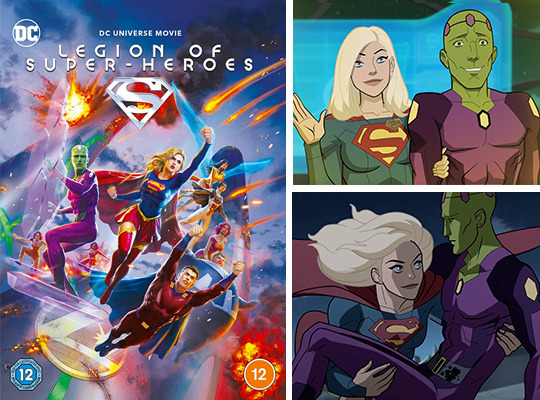
And make sure you watch the "Far From Home" episode of Justice League Unlimited (season 3, episode 10) too! It's basically a 20-minute speed-run of Kara and Brainy's relationship and it's veryyy cute. (It's also one of the only stories I can think of that gives them a happy ending.)

Anyway, that's all I've got for now! I hope this was helpful!! I'm sure I'm forgetting some stuff, but in my defense it's almost 2 AM right now lol.
If anyone else has other Karadox things to rec, feel free to add on to this!
#karadox#supergirl#brainiac 5#kara zor-el#querl dox#legion of super heroes#losh#karadox recs#dc comics#jlu#asks
29 notes
·
View notes
Text
Franchise / Asterix
Awesome
Characters
ComicBook
FanficRecs
Film
Franchise
Fridge
Funny
Headscratchers
Heartwarming
Laconic
NightmareFuel
Pantheon
Quotes
Recap
TearJerker
Trivia
VideoGame
WMG
YMMV
ReferencedBy
Create New - Create New - Analysis FanWorks Haiku ImageLinks PlayingWith Synopsis Timeline
📷"Par Toutatis!"Advertisement:
Astérix is a character created by René Goscinnyand Albert Uderzo in 1959 for the French comic magazine Pilote. The series' growing success in Pilote got it published into albums soon after.
The year is 50 B.C. Gaul is entirely occupied by the Romans. Well, not entirely... One small village of indomitable Gauls still holds out against the invaders. Said village is the home of Astérix, who frequently goes on all kinds of adventures, often in order to foil the plans of the Romans. He is helped in his adventures by Getafix, the druid of the village who holds the secret of a Super Strength-inducing potion, and most importantly his best friend Obelix, a menhir carver who fell in a cauldron of the aforementioned potion when he was a child, making the effects permanent on him.
Since its creation, Astérix has become a prominent figure in French-Belgian culture, and has managed to acquire fame on an international level, a rare occurrence for a French-Belgian comic character. It has been translated in over a hundred languages, and the comic book series, currently 37 albums long, has been adapted into animated features, live-action movies, video games, theme parks, tabletop games and whatnot. It also notoriously features on mustard glasses.
Advertisement:
Comic book series:
Asterix (since 1959) - For individual albums, see the Recap page.
Special albums
Astérix et ses Amis (2007) - Special tribute album for Albert Uderzo on his 80th birthday.
Animated feature films
Traditional animation:
Asterix the Gaul (1967)
Asterix and Cleopatra (1968)
The Twelve Tasks of Asterix (1976)
Asterix Versus Caesar (1985)
Asterix in Britain (1986)
Asterix and the Big Fight (1989)
Asterix Conquers America (1994)
Asterix and the Vikings (2006)
CGI animation:
The Mansions of the Gods (2014)
The Secret of the Magic Potion (2018)
Advertisement:
Live action adaptations
Two Romans in Gaul (1967) note
Asterix & Obelix Take on Caesar (1999)
Asterix & Obelix: Mission Cleopatra (2002)
Asterix at the Olympic Games (2007)
Asterix & Obelix: God Save Britannia (2012)
Books
How Obelix Fell into the Magic Potion When he was a Little Boy (1989) - Text with illustrations.
Theme parks
Parc Asterix (opened in 1989)
Video games
Asterix Operation Getafix (Action-adventure, 1989)
Asterix (Beat-Em-Up, 1992)
Asterix & the Great Rescue (Platform, 1993)
Asterix: The Gallic War (Strategy, 1999)
Asterix & Obelix Take On Caesar (Minigames, 1999, based on the film)
Asterix & Obelix XXL (Action-adventure, 2004)note
Asterix & Obelix XXL 2: Mission: Las Vegum(Action-adventure, 2006)
Asterix & Obelix XXL 2: Mission: Wifix(Platform, 2006)
Asterix & Obelix XXL 3: The Crystal Menhir(Action-adventure, 2019)
Advertisement:PreviousIndexNext
Art the Clown
Film Series
Austin Powers
Tales of the Galli
Ancient Rome
Histeria!
Assassin's Creed
Franchise Index
Astro Boy
Arthur
Trope Overdosed
Asterix
Supergirl
Long-Runners
Okaasan to Issho [email protected].
5 notes
·
View notes
Photo

A gif of Barry and Iris over the years!
I don’t have images for every year. The years are based on they year the books/ movie/episodes/ were released. It’s not necessarily chronological. You’ll see several images of Barry and Iris in wedding clothes for example, because books in later years sometimes showed flashbacks to their wedding.
So for the comics basically if there was a book released that year that had an image of them in it, regardless of where that image fits in the timeline.
Haven’t added everything yet (like Barry and Iris from Young Justice)
For 1989 I didn’t like the image I had with both of them in it, so I used 2 images with just one of them
Comic images from:
1956: Showcase (1956-1978) #4
1957: Showcase (1956-1978) #8
1958: Showcase (1956-1978) #14
1959: Vol 1: 108
1960: Vol 1: 111
1961: Vol 1: 122
1962: Vol 1: 133
1963: Vol 1: 137
1964: Vol 1: 142
1965: Vol 1: 151
1966: Vol 1: 165
1967: Vol 1: 174
1968: Vol 1: 182
1969: Vol 1: 186
1970: Justice League of America (1960) 80,
1971: Vol 1: 203
1974: Justice League of America (1960): 110
1975: Vol 1: 233
1976: Teen Titans (1966 -1978): 44
1978: Justice League of America (1960): 157
1979: Vol 1: 275
1980: Vol 1: 284
1981: Vol 1: 300
1985: 350
1988: Secret Origins (1986-1990): Annual #2 (starring Flash)
1989: Secret Origins (1986-1990) #46
1990: Secret Origins (1986-1990) #50
1991: The flash 50th anniversary special edition
1992: vol 2 63
1994: vol 2: 92
1995: Legion of Super-Heroes(1989-2000) Annual #6
1996: Legion of Super-Heroes (1989-2000) #88
1997: Life Story of The Flash
1998: The Flash 80-Page Giant (1998) #1
1999: Flash vol 2: 150
2001: JLA Incarnations: 5
2003: JLA worlds greatest heroes: Secret Origins
2004: JLA: Liberty and Justice
2005: JLA Classified:11
2006: Fastest man alive #1
2007: vol 2:234
2008: final crisis rogue’s revenge 1
2009: Rebirth 2
2010: Rebirth 6
2011: vol 3: 11
2012: vol 4: 5
2013: vol4: 17, 25
2014: vol 4: 33
2015: justice league darkseid war the flash
2016: vol 5: 13
2017: vol 5: 26
2018: vol 5: 45
2019: vol 5: 62, The Flash Giant (wave 2) #1
2020: The Flash #750
Other:
2013: Justice League: The Flashpoint Paradox
2014: The Flash 1x01
2015: The Flash 1x15
2016: The Flash 2x21
2017: Crisis on Earth X 1 (Supergirl episode), Justice League
2018: The Flash 5x08
2019: The Flash 5x10
2020: The Flash 6x10
*The image of the cut Justice League scene with Barry and Iris was posted by Zack Snyder on Vero but I got it from here. He didn’t post it till 2019, but since it’s from the movie I put it in the year the movie was released
*Also used: Promo pictures for the flash tv show from the far far away site
#the flash#westallen#64YearsOfWestallen#barry allen#iris westallen#iris west#64 years of westallen#newsflash#flash comics#the flash comics#dc comics#the flash comic spoilers#spoilers#the flash 750 spoilers
25 notes
·
View notes
Text
TOP 10 ARTISTS OF 2019′S REVIEWS
Believe it or not, it is harder to “rank” artists than writers, for comic-books. Most of the time, what you see is mostly a collaboration of many artists, and not always an ugly style is a bad thing. Art is subjective and that is why I am not doing a “bottom 10″ list of artists these years. It just wouldn’t make sense.
But because this year I took all sixty-something review that scored 10, while that is still a long list of artists, I was able to see which artists were more prominent in the material I read this year. This may or many not make sense to you, and it might not even make sense at all. But here it comes.
NUMBER TEN
JERRY ORDWAY (1957 - PRESENT)

Jeremiah Ordway (born November 28, 1957) is an American writer, penciller, inker and painter of comic books.
He is known for his inking work on a wide variety of DC Comics titles, including the continuity-redefining Crisis on Infinite Earths (1985–1986), his long run working on the Superman titles from 1986–1993, and for writing and painting the Captain Marvel original graphic novel The Power of Shazam! (1994), and writing the ongoing monthly series from 1995–1999. He has provided inks for artists such as Curt Swan, Jack Kirby, Gil Kane, John Buscema, Steve Ditko, John Byrne, George Perez and others.
Jerry Ordway was inspired in his childhood by Marvel Comics, and dreamed of drawing Daredevil, Spider-Man, and the Avengers. To date he has only worked on the latter.
Ordway attended Milwaukee Technical High School, where he took a three-year commercial art course, before joining a commercial art studio as a typographer in 1976. He subsequently worked his way "from the ground floor up at the art studio" between 1978 and 1981.
Ordway is married to Peggy May Ordway (b. 1959).
While Ordway’s work this year that made him into the list is “Crisis on Infinite Earths”, I think that I am doing a special mention for him. He was inker for that series (And this year, I will be separating pencillers from the rest), but Ordway’s pencils have so much personality, that you sometimes forget he is just inking.
NUMBER NINE
GARY FRANK (1969 - PRESENT)

Gary Frank (born 1969) is a British comics artist, notable for pencilling on Midnight Nation and Supreme Power, both written by J. Michael Straczynski. He has also worked with author Peter David on The Incredible Hulk and Supergirl. He had a creator-owned series, Kin, which he wrote himself, published by Top Cow Productions in 2000.
Writer Geoff Johns, who has collaborated with Frank, has opined that Frank's rendition of Superman is the best of his generation and that the only other artist in the same league with Frank in this regard is Curt Swan.
Gary Frank began his professional career in 1991, illustrating covers and interior short stories for publications such as Doctor Who Magazine and Toxic!. This led to a stint at Marvel UK in 1992 as regular series' artist on Motormouth & Killpower. It was on that series that he began a long-running collaboration with inker Cam Smith, who would continue to ink Frank's work for many years. In 1992, Frank was recruited by Marvel Comics to illustrate covers for The Incredible Hulk, beginning with issue No. 400. Shortly thereafter, he was hired as the series' ongoing artist beginning with issue No. 403 (March 1993) and ending with No. 425 (Jan. 1995).
During his initial time at Marvel, Frank contributed covers, interiors and pin-up illustrations for various series, such as X-Men Unlimited, the Sabretooth Special, X-Men Classic, X-Men Prime, and Doctor Strange, Sorcerer Supreme, among others. He drew covers for Acclaim Comics' Ninjak and Harris Comics' Vampirella.
In 1996, Frank and Smith were hired as the art team on DC Comics' new Supergirl ongoing series, which re-teamed Frank with writer Peter David. Frank's run as penciller ended with issue No. 9 (May 1997), although he continued to provide covers for the series until issue No. 21. Other assignments for DC included a Birds of Prey one-shot and the DC/Marvel Amalgam Comics one-shot, Bullets and Bracelets.
In 1997, Frank and Smith moved to Image Comics, where they, along with writer John Arcudi, were hired as the new creative team on the Wildstorm title Gen¹³, beginning with the epilogue story in issue No. 25. Their run on the series was praised for its dark, realistic style in both writing and art; however, the drastic change in tone and style alienated many longtime fans who had grown accustomed to the more fantastical and cartoonish approach of the Brandon Choi/J. Scott Campbell run. The Arcudi/Frank/Smith tenure on the series lasted two years, until issue No. 41 (July 1999). It was during this run, in 1998, that Wildstorm head Jim Lee moved his studio and all its properties to DC Comics. Therefore, issues No. 25–36 were published by Image and issues No. 37–41 were published by DC/Wildstorm.
Gary made it into the list because of his work with Geoff Johns on Justice League (including Shazam’s origin). But he could have been included for his work on Doomsday Clock as well.
NUMBER EIGHT
DAVE GIBBONS (1949 - PRESENT)

David Chester Gibbons (born 14 April 1949) is an English comics artist, writer and sometimes letterer. He is best known for his collaborations with writer Alan Moore, which include the miniseries Watchmen and the Superman story "For the Man Who Has Everything". He was an artist for 2000 AD, for which he contributed a large body of work from its first issue in 1977.
Gibbons was born at Forest Gate Hospital in London, to Chester, a town planner, and Gladys, a secretary. He began reading comic books at the age of seven. A self-taught artist, he illustrated his own comic strips. Gibbons became a building surveyor but eventually entered the UK comics industry as a letterer for IPC Media. He left his surveyor job to focus on his comics career.
Gibbons was one of the British comic talents identified by Len Wein in 1982 for American publisher DC Comics: he was hired primarily to draw "Green Lantern Corps" backup stories within the pages of Green Lantern. Gibbons' first DC work was on the Green Lantern Corps story in Green Lantern No. 161 (February 1983), with writer Todd Klein, as well as the concurrently released "Creeper" two-part backup story in The Flash #318–319. Gibbons drew the lead story in The Brave and the Bold No. 200 (July 1983) which featured a team-up of the Batmen of Earth-One and Earth-Two. With Green Lantern No. 172 (Jan. 1984), Gibbons joined writer Wein on the main feature while continuing to illustrate the backup features. In issue No. 182, Wein and Gibbons made architect John Stewart, who had been introduced previously in issue No. 87, the title's primary character. Ceding the "Tales of the Green Lantern Corps" backup features to various other individuals from No. 181, Gibbons last issue with Wein was issue No. 186 (March 1985). Gibbons returned to pencil the backup story "Mogo Doesn't Socialize" with Alan Moore in issue No. 188.
While Marvel Comics reprinted some of Gibbons' Marvel UK Doctor Who work, Eclipse Comics reprinted some of his Warrior work and Eagle reprinted various Judge Dredd tales, Gibbons continued to produce new work almost exclusively for DC throughout the 1980s. For the 1985 Superman Annual No. 11, Gibbons drew the main story "For the Man Who Has Everything", again written by Alan Moore.
During 1985 and 1986, Gibbons' artwork graced the pages of several issues of both DC's Who's Who: The Definitive Directory of the DC Universe and Marvel's The Official Handbook of the Marvel Universe Deluxe Edition. He was one of the contributors to the DC Challenge limited series and in December 1986, he contributed to Harrier Comics' Brickman No. 1 alongside Kevin O'Neill, Lew Stringer and others. Between May and August 1988, he contributed covers to The Phantom miniseries, inked Kevin Maguire's pencilled contribution to Action Comics No. 600, and produced the cover to Action Comics Weekly No. 601.
He is best known in the US for collaborating with Alan Moore on the 12-issue limited series Watchmen, now one of the best-selling graphic novels of all time, and the only one to feature on Time's "Top 100 Novels" list. Gibbons' artwork in Watchmen is notable both for its stark utilisation of the formulaic comicbook nine-panel grid layout, as well as for its intense narrative and symbolic density with some symbolic background elements suggested by Moore, others by Gibbons.
Gibbons lettered Watchmen and it was his lettering style that later served as one of two reference sources used by Vincent Connare when creating the controversial font Comic Sans in 1994. Gibbons has commented that "It's just a shame they couldn't have used just the original font, because it's a real mess. I think it's a particularly ugly letter form."
Comics historian Les Daniels noted that Watchmen "called into question the basic assumptions on which the super hero genre is formulated". DC Comics writer and executive Paul Levitz observed in 2010 that "As with The Dark Knight Returns, Watchmen set off a chain reaction of rethinking the nature of super heroes and heroism itself, and pushed the genre darker for more than a decade. The series won acclaim...and would continue to be regarded as one of the most important literary works the field ever produced."
Gibbons returned to Watchmen in 2008, producing the behind-the-scenes book Watching the Watchmen to tie into the release of the 2009 film. Watching the Watchmen is his take on the creation of the seminal work, and features a number of rarely seen pieces of artwork including sketches and character designs, as well as "stuff," he says "that I just don't know why I kept but I'm really pleased I did." Gibbons stated that "I'm basically thrilled with the movie, you know; it's been in the making for years. There have been proposals to make it – some I was excited about, some I was less excited about. But I think the way that it finally has been made is just great. I honestly can't imagine it being made much better."
Gibbons was present in many reviews this year, but he made it into the list because of his work on “Superman” and “Watchmen”.
NUMBER SEVEN
BRIAN BOLLAND (1951 - PRESENT)

Brian Bolland (born 26 March 1951) is a British comics artist. Best known in the United Kingdom as one of the definitive Judge Dredd artists for British comics anthology 2000 AD, he spearheaded the 'British Invasion' of the American comics industry, and in 1982 produced the artwork on Camelot 3000 (with author Mike W. Barr), which was DC Comics' first 12-issue comicbook maxiseries created for the direct market.
His rare forays into interior art also include Batman: The Killing Joke, with UK-based writer Alan Moore, and a self-penned Batman: Black and White story. Bolland remains in high demand as a cover artist, producing the vast majority of his work for DC Comics.
Brian Bolland was born in Butterwick, Lincolnshire, to parents Albert "A.J." John, a fenland farmer, and Lillie Bolland. He spent his "first 18 years" living "in a small village near Boston in the fens of Lincolnshire, England," but has "no memory of comics" much before the age of ten. When American comics began to be imported into England, c.1959, Bolland says that it "took a little while for me to discover them," but by 1960 he was intrigued by Dell Comics' Dinosaurus!, which fed into a childhood interest in dinosaurs of all shapes and sizes. Comics including Turok, Son of Stone and DC Comics' Tomahawk soon followed, and it was this burgeoning comics collection that would help inspire the young Bolland to draw his own comics around the age of ten with ideas such as "Insect League." He recalls that "[s]uperheroes crept into my life by stealth," as he actively sought out covers featuring "any big creature that looked vaguely dinosaur-like, trampling puny humans." These adolescent criteria led from Dinosaurus! and Turok via House of Mystery to "Batman and Robin [who] were [often] being harassed by big weird things, as were Superman, Aquaman, Wonder Woman [etc]." Soon, family outings to Skegness became an excuse for the future artist to "trawl... round some of the more remote backstreet newsagents" for comics to store on an overflowing "bookcase I'd made in school woodwork especially."
As early as 1962, aged 11, Bolland remembers thinking that "Carmine Infantino's work on the Flash and Gil Kane's on Green Lantern and the Atom had a sophistication about it that I hadn't [previously] seen. The young Bolland did not rate Marvel Comics as highly as DC, feeling the covers cluttered and the paper quality crude. His appreciation of the artwork of Jack Kirby, he says, only materialised much later "through the eyes of a seasoned professional." Despite such a variety of inspirations, Bolland credits his eventual pursuance of art as a hobby and then vocation to a primary school art teacher, who "evidently said all the right things to me."
Growing up as "and only child in a house without culture," (Bolland says that his "mother and father had no use for art, literature or music"), he embraced the late 1960s pop culture explosion of "pirate radio stations, music (particularly Frank Zappa...), drug taking, psychedelia, "peace and love," "dropping out," the underground scene, Oz Magazine," and other aspects of hippy culture epitomised by underground comix such as Robert Crumb's Zap Comix. Having taken both O-Level and A-Level examinations in art, Bolland spent five years at art school (starting in 1969) learning graphic design and Art history. Learning to draw comics, however, was "more a self-taught thing," with Bolland eventually writing a 15,000-word dissertation in 1973 on Neal Adams – an "artist [his teachers] had never heard of." He would later recall:
It was during this time that I discovered the sheer range of comics and their history. All the British stuff I'd missed was there to be discovered. I found the American greats, Foster, Herriman, Alex Raymond and Winsor McCay... Noel Sickles, Milt Caniff, Roy Crane, had all, I discovered, put down the basic building blocks of our "Art form". And there were the Europeans... Moebius, Manara, Breccia. Later the Filipinos—Alex Niño, Nestor Redondo, Alfredo Alcala, all were inspirational. None of this stuff was to be found in the art schools. During my five years in three art schools I never learnt a single thing about comics from any of my tutors.
Bolland was among the first British comics creators 'discovered' by the American comics industry, spearheading the so-called "British Invasion" in 1979/80. Bolland recalls that his big break came when Joe Staton attended the Summer 1979 Comicon, and, needing somewhere to work (on Green Lantern) while in the UK, arranged to stay with the Bollands. Staton called his editor Jack Harris and told him that Bolland, a big Green Lantern fan, would like to draw a Green Lantern cover; Harris agreed. He drew several covers for DC Comics, starting with Green Lantern No. 127 (April 1980), as well as some fill-in stories. These stories included, in 1980-1981, "Certified Safe" in Mystery in Space and "Falling Down to Heaven" in Madame Xanadu, DC's first attempt at marketing comics specifically to the "direct market" of fans and collectors. For editor Julius Schwartz, Bolland drew covers around which writers would craft stories, which included two Starro covers for Justice League of America No. 189 and 190 and Superman No. 422 (Aug. 1986).
Among his earliest interior work for DC was a chapter in Justice League of America No. 200 (March 1982) alongside artistic heroes Joe Kubert, Carmine Infantino and Gil Kane, as well as Jim Aparo, George Pérez and Dick Giordano. This gave the artist his "first stab at drawing Batman." Bolland felt that "after my cover [GL #127] worked out the people at DC turned their gaze on London... and particularly on the group of artists at 2000AD who had been weaned on the DC characters." He recalled that, "after I was settled in at DC, scouts from that company came to our "Society of Strip Illustration" meetings to win over a few more of us," making a "formal invitation" at an SSI meeting, which saw "Dave Gibbons, Kevin O'Neill... [t]hen Alan Davis and Mark Farmer," following the artists "Alan Grant "went across" and, at some point, a certain tall hairy writer from the Midlands."
In 1982, DC editor Len Wein chose Bolland to be the artist on DC's Camelot 3000 12-issue maxi-series, with writer Mike W. Barr. The story, dealing with the return of King Arthur to save England from an alien invasion in the year 3000, not only "represents the single biggest body of work" by Bolland – and his only attempt to draw a monthly title – but was also the "first example of a DC (or otherwise) maxi-series." Bolland was not familiar with the Arthurian legends, and initially conceived Merlin as a comical character. The series was graced with considerable media hype, and Bolland found himself "whisked off to San Diego and places and made a fuss of." Bolland was allowed to pick between two inkers, but opted to ink his covers himself. Bolland was uncomfortable with having a third party ink his pencils, and later admitted that he put a high level of detail into his art for the series to leave as little room as possible for the inker to creatively reinterpret his work. However, "by the end I was quite pleased with the results." Reacting indignantly to being presented with Ross Andru layouts for the first two Camelot 3000 covers, he chose to ignore [the Andru design] completely and come up with my own unapproved design. Len Wein rejected it and told me to do the Ross Andru one. Grudgingly I drew the number one cover that made it onto the issue – but as a protest I reversed the letter N in my signature as a code to remind myself that my "artistic integrity" had been despoiled. I liked the backwards N enough to keep it from that day on.
Camelot 3000 had lengthy delays between its final issues. Bolland recalled that he and DC "talked quite a bit about how long it would take me to do the series," and because the series was inked by other artists, he started off "churning the pages out with great enthusiasm." As the series continued, however, Bolland became increasingly meticulous, "trying to make the pages look better and better". The added details he introduced into his artwork caused significant delays in the final issues of the limited series, causing issues #8–11 to be released on a quarterly rather than monthly status, and the final issue to be cover dated nine months later than the penultimate issue.
Bolland married his girlfriend, illustrator and sometime-collaborator Rachel Birkett in 1981. She later gave up illustration "to become a cook in a vegetarian restaurant, although she has since assisted her husband with his work, acting as colourist, inker, co-artist and ghost. The two have a son, Harry.
The Camelot 3000 limited series, which he created with Mike W. Barr, was nominated for the 1985 Kirby Award for Best Finite Series, narrowly losing to Marv Wolfman and George Pérez's Crisis on Infinite Earths. In 2002, he placed second behind Jack Kirby for the title of "Best Artist Ever" in the short-lived National Comics Awards.
Brian Bolland made it to the list because of... you probably guessed it... “Camelot 3000″ and “Batman: The Killing Joke”.
NUMBER SIX
FRANK MILLER (1957 - PRESENT)

Frank Miller (born January 27, 1957) is an American comic book writer, penciller and inker, novelist, screenwriter, film director, and producer best known for his comic book stories and graphic novels such as Ronin, Daredevil: Born Again, The Dark Knight Returns, Batman: Year One, Sin City, and 300.
He is in both, Writer and Artist list, and, surpise, surprise, for pretty much the same stuff (”The Dark Knight Returns”, “Ronin” and also “Wolverine”).
NUMBER FIVE
MIKE DRINGENBERG (1965 - PRESENT)

Mike Dringenberg (born c. 1965) is an American comics artist best known for his work on DC Comics/Vertigo's Sandman series with writer Neil Gaiman. Mike Dringenberg was born in Laon, France.
Dringenberg first work in the comics industry was the story "A Tale Of... Lenny's Casino & Grill" in Kelvin Mace #1 (Dec. 1985) published by Vortex Comics. His other early work in the 1980s for publishers such as Eclipse Comics included Alien Worlds, Enchanter, and Total Eclipse. He worked on Adolescent Radioactive Blackbelt Hamsters, a parody of Teenage Mutant Ninja Turtles, which itself was a parody of many then-current comic books, and Shock the Monkey. His mainstream work includes DC's Doom Patrol with writer Grant Morrison, where he co-created Flex Mentallo; the fantasy card game Magic: The Gathering; and White Wolf Publishing's card game Vampire: The Eternal Struggle.
Mike is in this list because of his work on “The Sandman”.
NUMBER FOUR
RICK VEITCH (1951 - PRESENT)

Richard Veitch (born May 7, 1951) is an American comics artist and writer who has worked in mainstream, underground, and alternative comics. Rick Veitch is from a large Catholic family of six children. He was raised in Bellows Falls, Vermont.
Veitch made his publishing debut in 1972, illustrating the underground comix horror parody Two-Fisted Zombies published by Last Gasp and written by his brother Tom Veitch. This one-shot was excerpted in Mark Estren's History of Underground Comix. It also, according to Veitch, proved to be his ticket to admission to Joe Kubert School.
Veitch then studied cartooning at The Kubert School, and was in the first class to graduate from the school in 1978, along with his future long-time collaborators Stephen R. Bissette and John Totleben.
Veitch's next major project was an adaptation of the film 1941 with Bissette.
During the 1980s, Veitch became known as a distinctive fantasy artist and writer for Marvel Comics' Epic Comics line, for which he created three graphic novels, Abraxas and the Earthman serialized in Epic Illustrated; Heartburst published as a standalone graphic novel; and The One originally published as a six-issue comic book limited series. Heartburst was straightforward science fiction, while The One was an ambitious and bizarre fantasy-adventure involving monstrous superheroes, the Cold War, and spiritual evolution. During this period Veitch also contributed numerous self-contained comics short stories to Epic Illustrated.
Veitch's highest-profile title was DC Comics' Swamp Thing. His friends Totleben and Bissette had both illustrated the series since Alan Moore took over as writer. Veitch joined the team for issue #37 (cover dated June 1985), in which Moore's popular character John Constantine was introduced, and appeared regularly after issue #50. He also worked with Moore on Miracleman, illustrating the story that graphically depicted the birth of Miracleman's child published by Eclipse Comics in Miracleman #9 (July 1986).
When Moore left the Swamp Thing series after issue #64, Veitch took over as writer, dividing art duties between himself and Alfredo Alcala. His Swamp Thing stories took a similar approach to Moore's, combining horror-fantasy, ecological concerns, and an encyclopedic knowledge of DC Comics fantasy characters; he gradually turned his attention from the DC Universe to history and mythology, using time travel to introduce his hero to a variety of legendary figures. This was to conclude in issue #91. Difficulties arose after Veitch's plan for issue #88, a story in which Swamp Thing met Jesus Christ, was scrapped by DC President Jenette Kahn. Although DC had approved Veitch's initial script for the Jesus story, the topic was later deemed too inflammatory and was cancelled at the last minute. The publisher and writer were unable to reach a compromise; Veitch quit, and vowed never to work for DC until the story saw print. Though the story arc has still never been printed, Veitch eventually did return to DC.
After leaving DC, Veitch turned to the alternative comics field, where the success of the Teenage Mutant Ninja Turtles had provided the impetus for a black-and-white independent comics boom. After doing a Teenage Mutant Ninja Turtles storyline for Mirage Studios, "The River", he began creating his own titles again, published by the Mirage spin-off Tundra Publishing.
Rick is one of the “revelations” of this year, to me. He was included in this list because of his work in both, “Swamp Thing” and “Teenage Mutant Ninja Turtles”. His TMNT story is one of my favorite TMNT stories of all time (even though it may or may not be canon).
NUMBER THREE
JOHN TOTLEBEN (1958 - PRESENT)

John Thomas Totleben (born February 16, 1958 in Erie, Pennsylvania) is an American illustrator working mostly in comic books.
After studying art at Tech Memorial in Erie, Totleben attended The Kubert School for one year. He then spent several years working for comics editor Harry "A" Chesler, producing illustrations for the Rubaiyat of Omar Khayyam; which never saw print. His first published work appeared in Heavy Metal in January 1979.
His first success in American comics, and still his best-known work, was as the inker of pencilled art by Stephen R. Bissette for the DC Comics title Swamp Thing, when the series was being written and reinvented by Alan Moore. Totleben and Bissette joined the series in 1983 shortly before Moore. Totleben's style was unusual for the time, and is still distinctive among U.S. comics artists, for its fluid layouts and heavily detailed rendering using a combination of stippling and hatching. He also painted covers for the series in oils and acrylic. Totleben inked the story in Swamp Thing #37 (June 1985) which introduced the John Constantine character.
As with most cases in this list, these artists can ink, color and pencil their own art. Totleben is another artists that made it into this list thanks to his work on “Swamp Thing”.
NUMBER TWO
STEPHEN R. BISSETTE (1955 - PRESENT)

Stephen R. "Steve" Bissette (born March 14, 1955) is an American comics artist, editor, and publisher with a focus on the horror genre. He is known for working with writer Alan Moore and inker John Totleben on the DC Comics series Swamp Thing in the 1980s.
Bissette was born and raised in Vermont, where he still lives, and was raised Catholic.
Shortly after the publication of his first work, Abyss (1976), Bissette enrolled in the first class of The Kubert School. Before his first year was completed, his work was being published professionally in the pages of Sojourn, Sgt. Rock, and Heavy Metal. In 1978, Bissette was among the Kubert School's first graduating class, along with classmates Rick Veitch, Tom Yeates, and others.
While still enrolled at The Kubert School, Bissette executed the logo for early New Jersey synth-pop band WKGB and drew the cover for the band's 1979 single "Non-Stop/Ultramarine" on Fetish Records.
His early work appeared in the pages of Heavy Metal, Epic Illustrated, Bizarre Adventures, Scholastic Corporation's Weird Worlds and Bananas illustrating stories written by Goosebumps founder and author R. L. Stine, and he worked with Rick Veitch on the graphic novelization of Steven Spielberg's motion picture.
Bissette is best known for his multiple award-winning collaboration with writer Alan Moore and inker John Totleben on DC Comics' Saga of the Swamp Thing (1983–1987).
Under the company name of Spiderbaby Grafix, he later published the horror anthology Taboo, the original home of Moore and Eddie Campbell's From Hell and Tim Lucas' Throat Sprockets illustrated by Mike Hoffman and David Lloyd. He created Tyrant, a comic book biography of a Tyrannosaurus rex, which lasted four issues. During this period, he edited the horror anthology Gore Shriek, published by FantaCo Enterprises.
Since 1991, Bissette has presented a lecture series on horror comics called "Journeys into Fear". Having since grown in scope into a five-part series, "Journeys into Fear" identifies 12th century Japanese ghost scrolls and the 16th Century Mixtec codices as early ancestors, and traces the genre from its roots in Winsor McCay's work such as Dream of the Rarebit Fiend. In 1996–1997, Bissette contributed five covers for a comic book series about another swamp monster, Hall of Heroes' Bog Swamp Demon.
Bissette subsequently worked with Moore, Totleben, and Rick Veitch on the Image Comics' limited series 1963, their final creative collaborative effort. From 1963, Bissette owns the characters Hypernaut, N-Man, and the Fury.
Scott McCloud's 24-hour comic project began as a dare to Bissette in 1990. Each created a 24-page comic in 24 hours. The 24-hour comics project evolved into a challenge taken up by numerous hopeful contributors, with several published collections, and inspired other time-limited creative projects. Bissette published the story A Life in black and white in his own comic book anthology SpiderBaby Comix #2 (SpiderBaby Graphix, 1997).
In 1993, Bissette and Stanley Wiater co-edited Comic Book Rebels: Conversations with the Creators of the New Comics, which featured interviews with such notable comics creators as Scott McCloud, Harvey Pekar, Dave Sim, Howard Cruse, Will Eisner, Peter Laird, Kevin Eastman, and Robert Crumb.
Bissette retired from the comics industry in 1999, alluding to what he termed a "generational shift." He teaches courses in Comic Art History, Drawing, and Film at the Center for Cartoon Studies in White River Junction, Vermont
Since 2005, Bissette has also edited and published Green Mountain Cinema, a trade paperback journal devoted to the independent cinema scene in his home state of Vermont, as well as five volumes of Blur, collecting his film reviews and criticism.
The Stephen R. Bissette Collection at Henderson State University in Arkadelphia, Arkansas, houses Bissette's works and memorabilia.
Bissette is in this list because of his work on “Swamp Thing”.
NUMBER ONE
GEORGE PÉREZ (1954 - PRESENT)

George Pérez (born June 9, 1954) is a retired American comic book artist and writer, whose titles include The Avengers, Teen Titans, and Wonder Woman. Writer Peter David has named Pérez his favorite artistic collaborator.
George Pérez was born in the South Bronx, New York City, on June 9, 1954, to Jorge Guzman Pérez and Luz Maria Izquierdo, who were both from Caguas, Puerto Rico, but who did not meet until approximately 1949 or 1950, after both had settled in New Jersey while searching for job opportunities. They married in October 26, 1954 and subsequently moved to New York, where Jorge worked in the meat packing industry while Luz was a homemaker. George's younger brother David was born May 28, 1955. Both brothers aspired at a young age to be artists. with George Pérez beginning to draw at the age of five.
Pérez's first involvement with the professional comics industry was as artist Rich Buckler's assistant in 1973, and he made his professional debut in Marvel Comics' Astonishing Tales No. 25 (Aug. 1974) as penciler of an untitled two-page satire of Buckler's character Deathlok, star of that comic's main feature. Soon Pérez became a Marvel regular, penciling a run of "Sons of the Tiger", a serialized action-adventure strip published in Marvel's long-running Deadly Hands of Kung Fu magazine and authored by Bill Mantlo. He and Mantlo co-created the White Tiger (comics' first Puerto Rican superhero), a character that soon appeared in Marvel's color comics, most notably the Spider-Man titles.
Pérez came to prominence with Marvel's superhero-team comic The Avengers, starting with issue No. 141. In the 1970s, Pérez illustrated several other Marvel titles, including Creatures on the Loose, featuring the Man-Wolf; The Inhumans; and Fantastic Four. Writer Roy Thomas and Pérez crafted a metafictional story for Fantastic Four No. 176 (Nov. 1976) in which the Impossible Man visited the offices of Marvel Comics and met numerous comics creators. Whilst most of Pérez' Fantastic Four issues were written by Roy Thomas or Len Wein, it would be a Fantastic Four Annual where he would have his first major collaboration with writer Marv Wolfman. Pérez drew the first part of writer Jim Shooter's "The Korvac Saga", which featured nearly every Avenger who joined the team up to that point. Shooter and Pérez introduced the character of Henry Peter Gyrich, the Avengers' liaison to the United States National Security Council in the second chapter of that same storyline. Writer David Michelinie and Pérez created the Taskmaster in The Avengers No. 195 (May 1980).
In 1980, while still drawing The Avengers for Marvel, Pérez began working for their rival DC Comics. Offered the art chores for the launch of The New Teen Titans, written by Wolfman, Pérez' real incentive was the opportunity to draw Justice League of America (an ambition of Pérez's which "seemed like a natural progress from the Avengers"). Long-time Justice League artist Dick Dillin died right around that time, providing an opportunity for Pérez to step in as regular artist. While Pérez's stint on the JLA was popular with fans, his career took off with the New Teen Titans. The New Teen Titans was launched in a special preview in DC Comics Presents No. 26 (October 1980). This incarnation of the Titans was intended to be DC's answer to Marvel's increasingly popular X-Men comic, and Wolfman and Pérez indeed struck gold. A New Teen Titans drug awareness comic book sponsored by the Keebler Company, and drawn by Pérez was published in cooperation with The President's Drug Awareness Campaign in 1983. In August 1984, a second series of The New Teen Titans was launched by Wolfman and Pérez. Moreover, Pérez's facility with layouts, details, and faces improved enormously during his four years on the book, making him one of the most popular artists in comics as evidenced by the numerous industry awards he would receive during this time.
Pérez took a leave of absence from The New Teen Titans in 1984 to focus on his next project with Marv Wolfman, DC's 1985 50th-anniversary event, Crisis on Infinite Earths. Crisis purportedly featured every single character DC owned, in a story which radically restructured the DC universe's continuity. Pérez was inked on the series by Dick Giordano, Mike DeCarlo, and Jerry Ordway. After Crisis, Pérez inked the final issue of Superman (issue #423) in September 1986, over Curt Swan's pencils for part one of the two-part story "Whatever Happened to the Man of Tomorrow?" by writer Alan Moore. The following month, Pérez was one of the artists on Batman No. 400 (October 1986) Wolfman and Pérez teamed again to produce the History of the DC Universe limited series to summarize the company's new history. Pérez drew the cover for the DC Heroes roleplaying game (1985) from Mayfair Games:167 as well as the cover for the fourth edition of the Champions roleplaying game (1989) from Hero Games.
Pérez is married to Carol Flynn. He has no children. He has a brother, David, and a niece and nephew. He is diabetic, and has undergone surgery for diabetic retinopathy. In May 2017, Pérez was admitted to a hospital with chest pains and was diagnosed as having had a heart attack while travelling to New Jersey for a convention. He was subsequently released from the hospital after having a coronary stent fitted.
George was already in last year’s TOP 10 and he made it again this year, thanks to his work on “New Teen Titans”, “Crisis on Infinite Earths”, “Whatever Happened to the Man of Tomorrow?” and “Tales of the Teen Titans”, including “The Judas Contract”.
As I said before, most of these artists are pencillers, but most of them can do anything. Now, I have another list of artists coming up, that have a bit more “rigid” in what they do, but they also excel at it.
The artists in this list are only a small group, among all the other artists that could have made it into this list, some of them being: A. C. Farley, Bruce Timm, Bryan Hitch, Chris Allan, Jim Lawson, Chris Sprouse, Curt Swan, Dave McKean, Denys Cowan, Frank Quitely, Gene Colan, Jesus Merino, Emanuela Lupacchino, Jim Aparo, Jim Lee, Joe Quinones, Keith Pollard, Marcos Martin, Matt Hollingsworth, Paul Gulacy, Richard Pace, Leonard Kirk, Dan Jurgens, Sam Keith, Shawn McManus, Stephen Byrne, The Dodsons, Tony Harris, Stan Sakai and Bob Burden. Thank you all, and thank you to the artists of this list for making 2019 a better year for me.
#artists#comics#review#george perez#stephen bissette#john totleben#rick veitch#mike dringenberg#frank miller#brian bolland#dave gibbons#gary frank#jerry ordway#2019
13 notes
·
View notes
Text
Why I’m Excited for “Crisis On Infinite Earths”
With the premier of the “Crisis On Infinite Earths” fast approaching, I recently began to reflect on why I’m so excited for it. Sure, I’m an avid Superman and DC comics fan and Crisis is an iconic story, but it’s more than that.
If you were to ask me “When did you know you were a Superman fan?” I would say, “Somewhere between 7 and 8 years old when my upstairs neighbor gave me his copy of The Death of Superman trade paperback.” Of course, at that age, I didn’t know what a “trade paperback” was. To me, it was a comic book; and like so many other children have done with their favorite comics, books, and toys, I carried it everywhere and read it to the point that I nearly had it memorized. I still have it. It’s beat to hell; but it’s bagged, boarded and stored in a safe place.
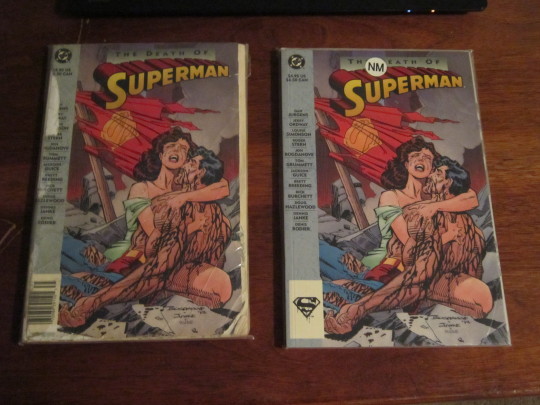
My copies of The Death of Superman TPBs. The one on the left I took everywhere with me when I was a boy.
If you asked me when I became a serious Superman fan and collector I would tell you “My 14th birthday, February 2000.”
My Aunt Susan gave me the Superman Masterpiece Collection for my birthday that year. The set came with a reprinted copy of Superman #1 (printed to the exact specifications of the comic books of that era), a hardcover book chronicling Superman’s Golden Age, and a limited edition statue designed by Alex Ross, made available only with that set.
I still have that, too. It’s a little worn along the edges and corners, but otherwise in excellent shape. I keep it on top of my bookcase. It’s one of my favorite pieces of memorabilia.
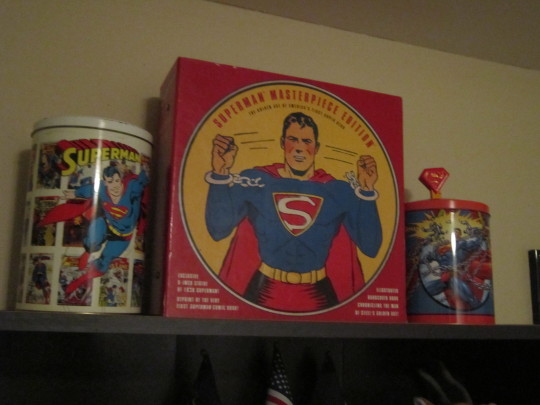
Even then, as much as I enjoyed comic books, I only saw them as a form of escapism; another way to keep people entertained. With explosions, science fiction, action, adventure, and romance; it was the modern version of the Greek mythology stories I read as a boy. They were a great way to keep myself entertained but not much else.
That perception changed when shortly after I graduated high school in 2004. I had received, among many other gifts, Barnes and Noble gift cards at my graduation party; and when I redeemed them, there were only two books I had my eye on:

Crisis On Infinite Earths (1985) and Kingdom Come (1996)
Crisis on Infinite Earths brought a new perception to these fictional characters that I had never before considered. There was depth, drama, and serious world-ending – in this case universe-ending – stakes. Universes were literally obliterated from existence , beloved characters were killed off, and the DC Universe was never the same again.
George Perez even introduced a character, Pariah, whose sole purpose was to witness the destruction of every universe, particularly every Earth, with no way to warn or save anyone. I even remember my jaw dropping at the beginning of the story when Earth 3, the home of the Crime Syndicate of Amerika – evil alternate versions of the Justice League, kicked off the story by being destroyed.
Crisis on Infinite Earths saw the teaming up of characters of the same name from different Earths with similar, but still different, backstories and abilities. The Superman of Earth 2, for example, was the Golden Age Superman; who’s abilities are limited to that of early Superman stories, “faster than a speeding bullet, more powerful than a locomotive, able to leap tall buildings in a single bound.” While the Earth 1 Superman was the modern incarnation with all of the abilities we are familiar with today, namely flight.
What made Crisis so successful, however, wasn’t just that there were variations of the same characters fighting side-by-side to save the multiverse from being wiped from existence, but that no one is safe. One of the most iconic covers of all-time is Crisis on Infinite Earths #7.
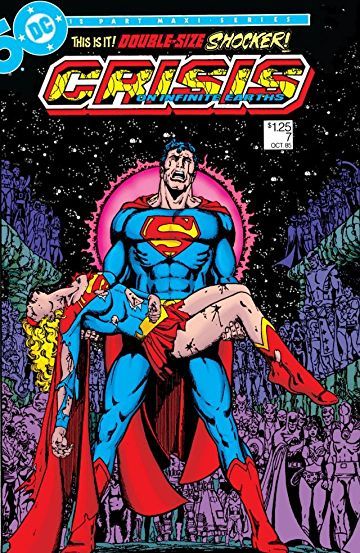
Cover of Crisis On Infinite Earths #7.
That basic design, a hero holding the body of a partner/friend/lover, has been used all throughout comic books; but Crisis on Infinite Earths #7 remains iconic not just because it features the world’s most powerful hero holding the dead body of his cousin, who’s abilities are nearly equal to his, reduced to a groveling mess, but because it was proof that absolutely no one was safe. By issue 7, everyone knew the stakes, and the heat was on.
What made Supergirl’s death so memorable and iconic, however, wasn’t just that she died in battle, but that she sacrificed herself, knowing what she was doing would kill her.
Following Crisis, DC rebooted the entire universe and in that reboot, they intended the Superman to be the last Kryptonian rather than the last son. So rather than letting Supergirl become another faceless casualty, she received a hero’s farewell by protecting her cousin - the entire reason she was sent to Earth in the first place.
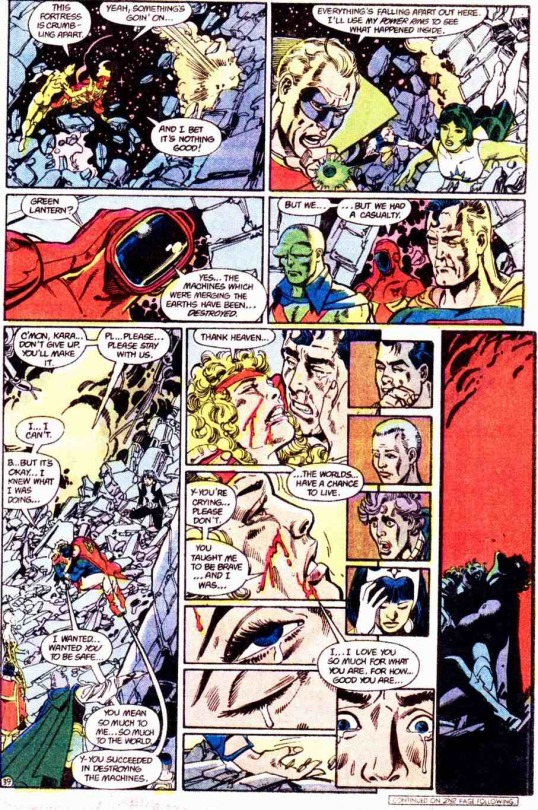
The death of Kara Zor-El.
The story didn’t slow down there, either, the following issue saw the death of Barry Allen, A.K.A. The Flash. While the cover isn’t nearly as iconic as the previous, Barry’s death is because it, again, involves self-sacrifice.

Cover of Crisis On Infinite Earths #8.
Throughout the story, Barry’s “ghost” would occasionally pop up, looking less and less ghastly each time; and that was finally explained in issue #8 when Barry ran to create a speed vortex that would draw power from the weapon designed to destroy Earth. The power became too much for his body to handle and he literally ran backwards in time until he disintegrated and became the very lightning bolt that gave him his abilities.
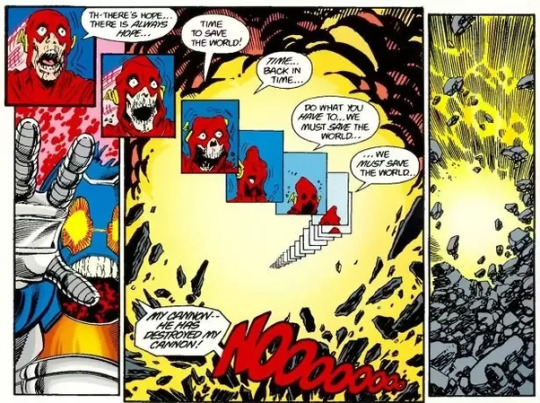
The Death of Barry Allen.
Crisis On Infinite Earths upped the ante in comic book storytelling. It showed that just because the characters aren’t real doesn’t mean they’re immortal and, more importantly, it shows that we can feel connected to them just like we get with a character in our favorite TV show. When I finished reading Crisis I began to take a deeper look at comic book characters and was able to identify what made each character great and different in their own way. Sure, Batman has the money, gadgets, and the car - but it doesn’t mean he won’t long for his parents anytime he sees Superman with Jonathan and Martha. There is much more to comic books than colorful costumes and wacky villains; and it was Crisis On Infinite Earths that helped me realize that.
After Crisis, I picked up Kingdom Come.
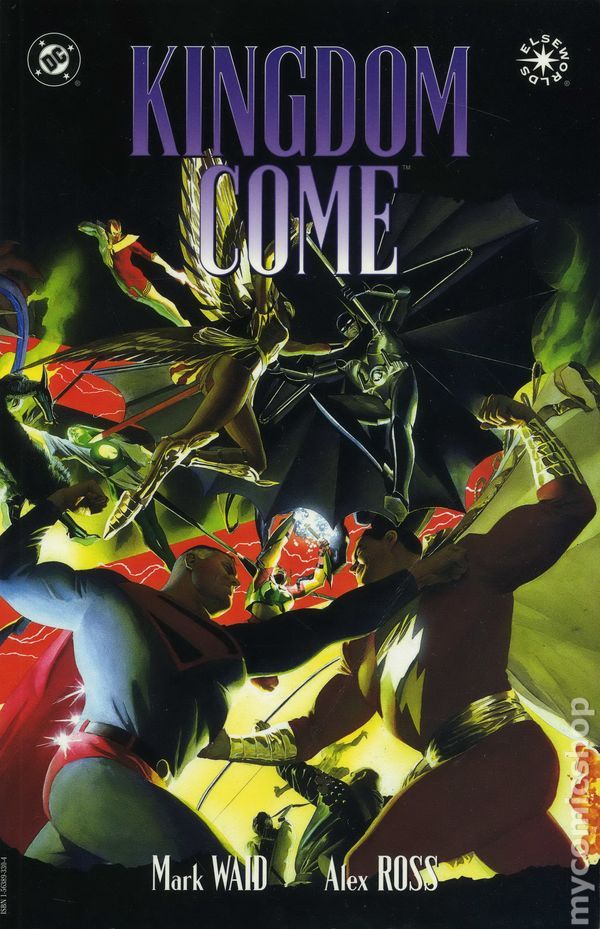
Wow.
Let me say that again.
Wow.
Putting aside the writing for now. The art alone is enough to sell the book. Alex Ross is a legend, and his art speaks for itself. I had only ever seen his work in single images, not in comic book panels and I was in awe with how well everything seamlessly flowed together. To this day, Alex Ross’ work in Kingdom Come is among my favorites and will always hold a very special place in my heart.
Now. The story.
Mark Waid could walk into a convention and my heart would stop.
He ranks among some of the very best comic book writers and when you read Kingdom Come, you’ll see why.
Like Crisis On Infinite Earths, Kingdom Come opened my eyes in comic book storytelling that I had never before considered; this time with politics. In my last YouTube video, I talked about how comic books have always been, in some way, political. As children we don’t notice it as much but when we grow, mature, and begin to notice how the world works, we finally become aware of topics we were blissfully unaware of as children. Politics in comic books is one of them.
With Kingdom Come the politics covers not only generational gaps between yesterday’s heroes and the story’s current heroes, but we also see the government get involved out of fear of the destruction the two groups of heroes could cause should they not resolve their differences. Within that narrative was the conflict occurring among the primary characters. Superman and Wonder Woman, while working together, did not see eye-to-eye, Batman wanted nothing to do with their efforts while (shockingly) assembling his own team in accordance with his own plan that involved Lex Luthor and other classic supervillains, and a brainwashed demigod as the wildcard.
Most of all, the story portrayed a war and how the biggest victims aren’t those fighting in it, but those they claim to be fighting for; the unintended casualties. Sure, we feel for the casualties of the war, but it wasn’t until an enraged Superman nearly brought the roof down on the government who did what they did not out of malice, but fear.

Superman nearly loses control in Kingdom Come #4.
Kingdom Come is easily one of the most powerful stories I have ever read and remains in my top 3 favorite stories. It’s one that I would recommend to anyone, even if they aren’t a comic book fan. Hell, the first Superman shirt I ever bought for myself was Kingdom Come.

I need to get a new one.
Then there’s Brandon Routh.
Routh (rhymes with “south”) was cast to play Superman in 2006’s Superman Returns. While the movie itself was a bit of a disappointment and divisive amongst fans, Routh’s performance as the Man of Steel was not.
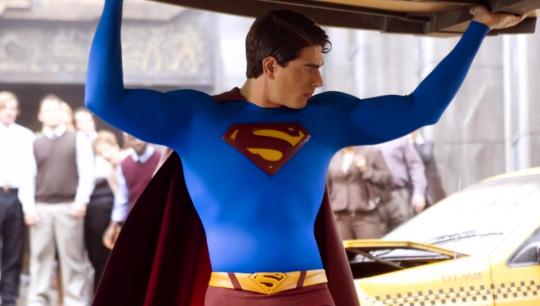
Brandon Routh as Superman in 2006’s Superman Returns.
I was 18 and in my first semester of college when the news of Routh’s casting hit. I was excited. Excited that he was an unknown actor. Excited that he was young and that a franchise could be built around him, excited that he grew up a Superman fan, excited that – like me – he grew up in a part of the country where Superman’s values are ingrained in everyday life. I was truly excited, even if other Superman fans weren’t.
Brandon Routh received, in my opinion, an unfair amount of criticism when he was cast, when pictures of him in the suit were released, when trailers were released, when the movie was released, and even to this day. Honestly, I feel fans and critics weren’t willing to give him a fair chance because he wasn’t Christopher Reeve and was compared to Reeve before the first picture of him in the suit was released. I was one of those fans who tirelessly defended him on the internet. I was insulted by fans, my family was insulted, called names, I was even accused of not being a “real Superman fan” because I was giving the movie my support. I was young, though, and didn’t realize then how pointless it was to argue over the internet; so I kept at it.
I was so excited for the movie I ordered my ticket for opening day the day tickets went on sale. I set out the Superman shirt I wanted to wear to the movie, drove an hour and a half from Limon, CO to Denver to see it, and arrived early to make sure I got a good seat. I had waited my entire life to see Superman on the silver screen and nothing was going to stop me from making it the best experience possible.
I’ll be honest. I enjoyed the movie. I was a bit underwhelmed because I had hoped for more action sequences and felt the story could have been stronger; but that didn’t stop me from walking out of the theater with a smile on my face, seeing it a second time, or looking forward to what the sequel had in store. Hell, at the time Superman Returns came out, I was an aspiring actor and I DREAMED of being cast as John Corben, also known as Metallo, in the Superman Returns sequel and going blow-to-blow with Routh’s Superman.
Ultimately, I think the premise had more to do with my excitement than anything else. I loved – LOVED – the idea of Superman being gone for 5 years and returning to a different world; especially with everything the world had been dealing with between 2000-2006.
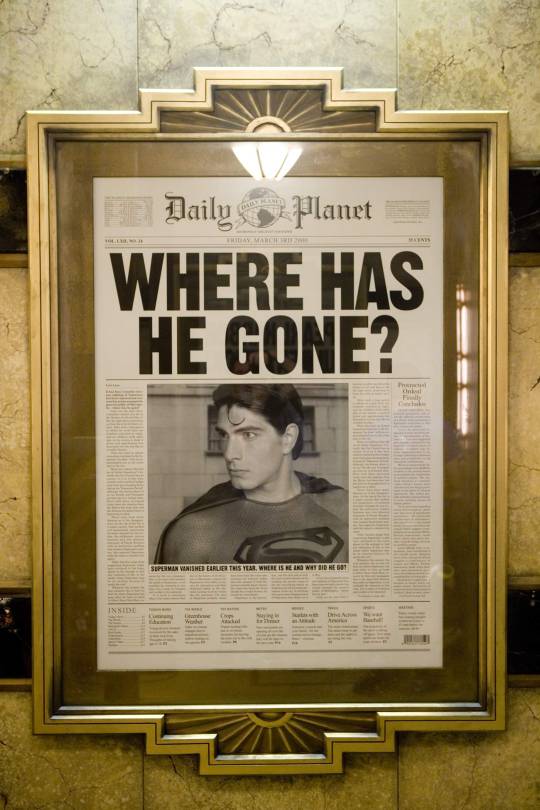
From Superman Returns. The date of the article is March 3, 2000.
What if we had Superman on 9/11? What would have been different? How many lives would have saved? Would he have stopped the second plane from hitting the south tower? Would he have prevented it altogether? There was so much that could have been done with that premise that, I feel, was left on the table.
To this day, I believe that instead of being a continuation of the Christopher Reeve films (a decision I supported at the time) I think Superman Returns should have featured a young Superman who fled back to Krypton when he heard the rumor it might still be there. Jason should have been Lois and Richard’s child, Martha should have died while Superman was away, Lex Luthor or Cadmus Labs (both?) should have been trying to clone their own Superman that would turn into Bizarro, Superman should have spent less time pining over his lost love with Lois, and I have always, and firmly, believed there should have been a scene of Clark sitting alone in the Daily Planet film room, glasses in hand and tears in his eyes, watching footage of the September 11th terrorist attacks. Those elements would not only have given Superman Returns a stronger story, it would have made him much more relatable to the casual moviegoer and still would have provided plenty of action for fans.
Despite all of that. I still enjoyed the movie. I enjoyed it so much that when it was available for pre-order on Amazon, I bought the Two-Disc Special Edition.

I still have it.
When Routh made an appearance at Rose City Comic Con in 2018, I made damn sure I met him.

He signed my copy of the Superman Returns comic book adaptation and I’m still geeking out about it.
Of everything I enjoyed in Superman Returns, the plane sequence, the bank robbery, Kevin Spacey’s Lex Luthor, Superman flying around saving the city; if I had to pick one thing that I enjoyed the most in the film, it would be Routh himself. While his portrayal of Clark Kent was clearly inspired by Christopher Reeve, his Superman is where he shined. He stood tall, walked and spoke with confidence, and could intimidate someone by his presence alone – until he smiled that warm Superman smile and said something that would calm even the most nervous person like he did with an upset Lois Lane on the roof of the Daily Planet.
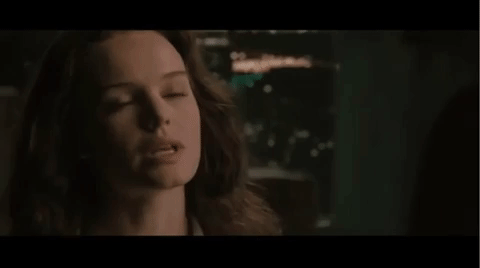
“Will I see you around?”
“I’m always around.”
Because Superman Returns didn’t fare as well in the box office as the studio had hoped, the sequel never happened and that was the end of Routh’s tenure as Superman. I was disappointed, but I understood. It’s a business. Making money comes first and Superman Returns, while profitable, didn’t make nearly enough.
Time marches on and we got more comic book adaptations. Smallville continued for another 5 seasons, ending its run after season 10 and inspiring a spin-off series about the Green Arrow, inspired by Justin Hartley’s popularity of the character in Smallville. Arrow, set apart from the Smallville series, came out swinging and quickly rose in popularity. Then in season 2, came future superheroes as recurring characters: Barry Allen, played by Grant Gustin, and Ray Palmer, played by Brandon Routh.
I was SO excited to see Routh back in the comic book medium. The only thing that would have made me happier was if they brought him back to play Superman; but alas, I knew it didn’t fit with Arrow’s reality.

Routh’s performance as Ray Palmer was different than I expected. Ray always came off as a serious character in the stories I read, not as the “Aw shucks” kind of person Routh portrays him as. It made sense, though. Stephen Amell’s Oliver Queen had enough serious to go around for everyone; there needed to be a lighthearted superhero to balance that – like Superman is to Batman.
It worked too! Routh became popular on the show and before too long, was starring alongside other actors who portrayed those lesser known heroes in Legends of Tomorrow. As the Arrowverse continued to up the ante and bring in other shows and characters, so did the expectations; and like the comics the shows are based on, annual crossovers became a thing.
They started small with the first 2 being two-parters with The Flash and Arrow, then expanded across all four shows for Invasion! and Crisis on Earth X, dropped to a 3-parter with Elseworlds while also setting up the Batwoman series, to an epic five-part series based on one of the most iconic stories of all time that showed me how serious comic book storytelling could be.
Then there’s Brandon Routh.
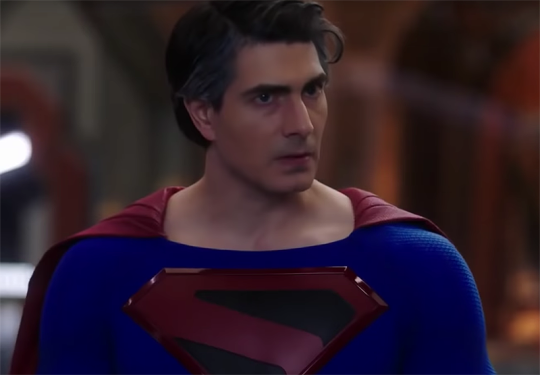
Not only is he returning to play Superman, he’s playing the Kingdom Come Superman!
I can’t take it anymore. Seriously.
The first actor I ever saw play Superman in theaters – the first Superman actor I have ever met in person, is playing the version of Superman that helped me realize the kind of message that comic books can tell, in an adaptation of an iconic story that showed how serious a comic book can get. Both of those stories, Kingdom Come and Crisis On Infinite Earths, made me into a comic book fan. Not just a Superman fan, but a comic book fan.
Now I have another comic book that I need to get signed by Routh the next time he visits the Pacific Northwest:

It’s gonna happen – and I’ll be sure to get a picture with him while wearing a Kingdom Come Superman shirt.
Fans can always remember what made them fans of their fandom. Crisis on Infinite Earths and Kingdom Come is that for me. Add the casting of Brandon Routh as Superman in Superman Returns shortly after reading those two iconic stories, and It was a done deal for me.
Seeing all of these impactful moments that helped mold my fandom being rolled together like this is, to say the least, emotional. Never in my life did I expect to see any type of live action adaptation of Kingdom Come or Crisis On Infinite Earths; and I certainly never imagined I’d see Brandon Routh play Superman again. It really is a fanboy’s dream come true.
The only thing that could make it better, for me anyway, would be if Routh’s final line as Superman is his best line as Superman:
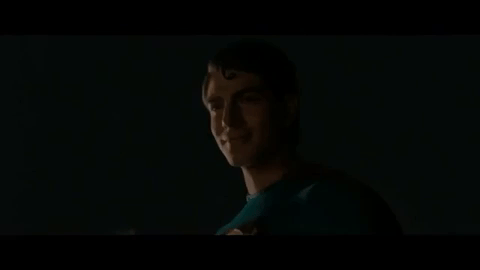
“I’m always around.”
#crisisoninfiniteearths#kingdomcome#superman#supermanreturns#arrowverse#arrow#flash#supergirl#legendsoftomorrow#brandonrouth#deathofsuperman#raypalmer#theatom#dccomics#cwtv#dctv#dcuniverse#dcmultiverse
2 notes
·
View notes
Text
"Yesterday's" Comic> Supergirl Movie Special
BW's "Yesterday's" Comic> Supergirl Movie Special (the 1980s movie adaptation)
It’s in better shape than my cover.
Supergirl Movie Special
DC Comics (1985)
SCREENWRITER: David Odell
ADAPTATION: Joey Cavalieri
ARTIST/COLORIST: Gray Morrow
LETTERER: John Costanza
EDITOR: Julius Schwartz
Continue reading
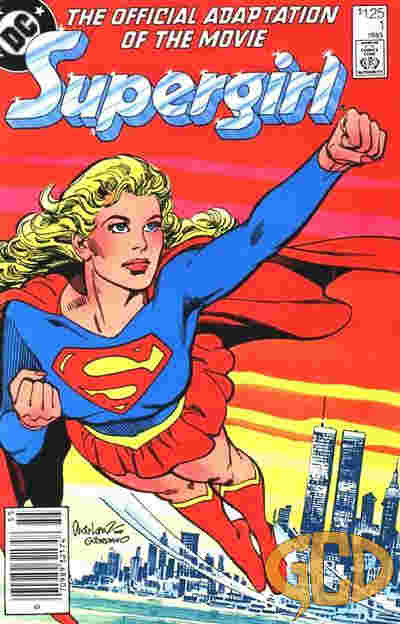
View On WordPress
0 notes
Text
Arrowverse: Crisis On Infinite Earths Air Date, Story & Cast Details

Here's everything to know about 2019's Arrowverse crossover, Crisis On Infinite Earths. Based upon the seminal 1985-1986 Crisis On Infinite Earths DC Comics maxi-series created by writer Marv Wolfman and artist George Perez, this year's Arrowerse crossover will be the superhero universe's biggest event yet and will span every Arrowverse series on The CW: The Flash, Supergirl, Arrow, Batwoman, and DC's Legends of Tomorrow.
Since the original Arrowverse crossover, Flash Vs. Arrow, in 2014, the annual crossover events have escalated in size and scope as The CW's superhero shared universe has grown. In 2016, The Flash and Arrow were joined by Supergirl and Legends of Tomorrow in Invasion! as the heroes teamed up to repel an attack by the alien Dominators. 2017's Crisis On Earth-X saw the wedding of Barry Allen (Grant Gustin) and Iris West (Candice Patton) interrupted by the heroes' Nazi doppelgangers from Earth-X. In 2018's Elseworlds, the Arrowverse grew even more by introducing Batwoman (Ruby Rose) and Gotham City, setting the stage for her new solo series. Elseworlds not only featured Green Arrow (Stephen Amell) and the Flash switching bodies, but the debut of the Monitor (LaMonica Garrett) also laid the groundwork for 2019's Crisis On Infinite Earths crossover event.
Related: Why A Smallville Crossover In Crisis On Infinite Earths Is So Difficult
It could be said that the Arrowverse has been building to Crisis On Infinite Earths for many years, in the same way that the Marvel Cinematic Universe culminated with Avengers: Endgame. Indeed, it's hard to imagine an Arrowverse event bigger than Crisis On Infinite Earths, which could potentially alter The CW's shared universe in fundamental ways - just as the comic book series redefined the DC Universe in the 1980s. Further, Crisis On Infinite Earths will honor previous superhero movies and TV series that influenced the Arrowverse by bringing in special guest stars, which should create major fan service moments. Here is everything to expect from Crisis On Infinite Earths.
Crisis On Infinite Earths Air Dates

Keeping with the monumental scope of the comic book story, Crisis On Infinite Earths will be the biggest Arrowverse crossover yet. The mega-event will span all five Arrowverse series and will be broken up into segments, with the first three hours airing on three consecutive nights in December 2019 and then the final two hours wrapping up the Crisis on the same night in January 2020 after the annual holiday hiatus. Here's how Crisis On Infinite Earth's schedule breaks down:
Supergirl: Sunday, December 8 @ 8pm - Crisis On Infinite Earths, Part 1
Batwoman: Monday, December 9 @ 8pm - Crisis On Infinite Earths, Part 2
The Flash: Tuesday, December 10 @ 8pm - Crisis On Infinite Earths, Part 3
Arrow: Tuesday, January 14 @ 8pm - Crisis On Infinite Earths, Part 4
Legends of Tomorrow: Tuesday, January 14 @ 9pm - Crisis On Infinite Earths, Part 5
Note that this Crisis schedule moves Supergirl up to 8pm on December 8; it otherwise airs at 9pm during the 2019/2020 Arrowverse season. Batwoman, which will normally air Sundays at 8pm, moves to Monday night for the Crisis. Also, the final two hours of Crisis on Tuesday, January 14 bumps The Flash from its normal night and moves Arrow up an hour from its normal 9pm slot this season. Additionally, Legends of Tomorrow's Crisis conclusion is considered a "special episode", with the time-traveling series getting a proper season 5 premiere later in January.
Related: Crisis on Infinite Earths: Why Kevin Conroy Is NOT Playing Batman
Crisis On Infinite Earths Story Details

The Crisis On Infinite Earths comics series eliminated the DC Comics Multiverse and merged all of its disparate continuities into one Prime universe. It involved the superheroes banding together to defend their various worlds as they're caught in the middle of a war between two cosmic beings who are siblings and opposites: the Monitor and the Anti-Monitor (both will be played by LaMonica Garrett). Given that the Crisis is about entire worlds being destroyed and merged into one reality, many fans speculate that Crisis On Infinite Earth's endgame is to do the same to the Arrowverse, specifically that it will bring Supergirl, which is set in Earth-38, into Arrow's Earth-1.
The Arrowverse's Crisis will pick up story threads that began with 2018's crossover, Elseworlds, where the Monitor made a secret bargain with Oliver Queen after the Green Arrow sacrificed himself to save Supergirl (Melissa Benoist) and the Flash. Arrow season 7 ended with Oliver leaving with the Monitor to prepare for the Crisis, the ramifications of which will be seen in Arrow season 8. Crisis On Infinite Earths will also pay off The Flash's story since season 1 in which a Central City newspaper's headline dated 2024 read "Flash Missing - Vanishes in Crisis". The events of The Flash season 5's finale moved the timeline of the Crisis up to 2019. Meanwhile, the Monitor made appearances in Supergirl and Legends of Tomorrow's season finales as well, setting up their roles in the Crisis.
Crisis On Infinite Earths also ominously teases major deaths: Oliver Queen could meet his demise since Arrow is ending with season 8. However, in the comics, both the Flash and Supergirl died saving the universe during the Crisis - could their tragic fates be echoed in the Arrowverse crossover as well?
Which Arrowverse Shows Are Crossing Over?

Not only are all five Arrowverse series - Supergirl, Batwoman, Arrow, The Flash, and Legends of Tomorrow - taking part in Crisis On Infinite Earths but characters from Black Lightning will also join the crossover. Black Lightning, which was originally developed for another network like Supergirl, isn't part of the Arrowverse but Crisis On Infinite Earths could end up changing the reality of the superheroes of Freeland as well.
Related: Crisis on Infinite Earths: Predicting Burt Ward's Arrowverse Character
Elseworlds also introduced Batwoman into the Arrowverse, setting the stage not just for her solo series on The CW but for the red-haired vigilante's role in Crisis On Infinite Earths. This will include a team-up with Batwoman and Supergirl since the two World's Finest heroines really hit it off when they met in Elseworlds.
Superhero Actors Returning For Crisis On Infinite Earths
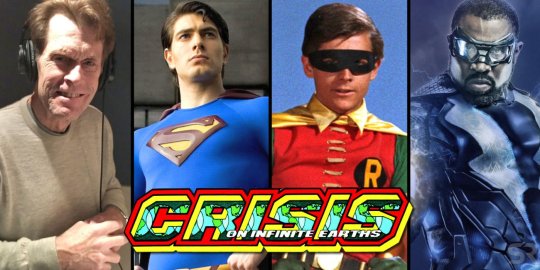
The Arrowverse is already bursting at the seams with superheroes across the five series, but Crisis On Infinite Earths will bring in even more heroes and villains to honor past DC Comics TV series and movies.
First, Crisis On Infinite Earths will feature more than one Superman: Tyler Hoechlin's Man of Steel from Supergirl will be joined by the Kingdom Come Superman, with Brandon Routh reprising the role he played in 2006's Superman Returns (Routh will likely also play Ray Palmer/The Atom from Legends of Tomorrow in Crisis). In addition, Supergirl's Lois Lane (Elizabeth Tulloch) and Lex Luthor (Jon Cryer) will have major roles in Crisis On Infinite Earths and the crossover is also expected to debut Lois and Clark's baby, paying off how the Super couple has been off the planet since Supergirl season 4.
Batman, whose whereabouts remain a mystery in Batwoman's Earth-1, will also be represented in Crisis On Infinite Earths: Kevin Conroy, who voiced the Dark Knight in Batman: The Animated Series and numerous other projects, will portray an older Bruce Wayne from the future. In addition, Burt Ward, who played Robin the Boy Wonder in the classic 1960s Batman TV series, will also appear in an unspecified role in Crisis On Infinite Earths.
Related: Kingdom Come Superman Explained: How Brandon Routh's New Version Is Different
Lastly, Tom Cavanagh, who plays multiple versions of Harrison Wells in The Flash, will play another new character: Pariah. In the comics, Pariah is a tragic being who is forced by the Anti-Monitor to watch every world be destroyed. Crisis On Infinite Earth's version of Pariah will play an integral role in unleashing the Anti-Monitor onto the Arrowverse.
Next: Predicting What 2020's New Arrowverse Show Will Be
source https://screenrant.com/crisis-infinite-earths-crossover-airdate-story-characters-updates/
0 notes
Photo


José Luis García-López and Dick Giordano Supergirl Movie Special #1 Cover Original Art (DC, 1985)
Look up in the sky -- it's a bird, it's a plane, no, it's the cover for the comic adaptation of the 1984 film Supergirl! Here, the "Girl of Steel" is seen flying high over New York City with the iconic World Trade Center in the background. This powerful image was created in ink over graphite on Bristol board with an image area of approximately 12" x 9.75". Slight toning, vellum overlay with inked city skyline, production notes, creasing near the top, with light staining and smudging/handling wear. Signed by García-López in the bottom left margin. In Very Good condition. Includes a copy of comic book.
https://tinyurl.com/fcxchxjr
1 note
·
View note
Photo



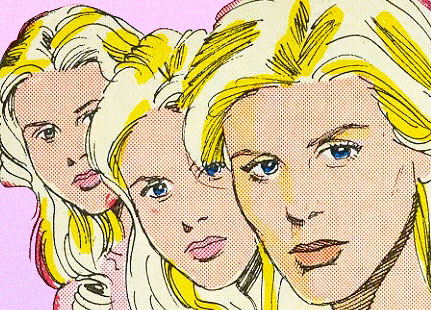
KARA ZOR EL
Supergirl Movie Special (1985)
art by Gray Morrow
#kara zor el#linda lee danvers#supergirl#supergirledit#dcedit#comicedit#comic: supergirl movie special (1985)
130 notes
·
View notes
Text
It is two and a half minutes to midnight, and the lines between fact and fiction are growing increasingly irrelevant–
As the “real news” reports the latest in “alternative facts” our country is overwhelmed with an odd sense of déjà vu, like we’ve been here before but forgot to take notes. All those years preaching “those who do not remember the past are condemned to repeat it” and look where it has gotten us:
Following the virally infamous Kellyanne Conway interview on January 22nd, our country appears condemned to repeat High School English while we’re at it. Sales of George Orwell’s iconic novel 1984 skyrocketed to the top of the charts, with hopes that It Can’t Happen Here putting Sinclair Lewis’s satirical tale closely in the running, and Aldous Huxley’s Brave New World coming up fast.
Today and for the next four years: don’t let the bastards grind you down. #handmaidstale pic.twitter.com/97A8a1waKd
— Erica R Hopper (@rememberedtales) January 20, 2017
Margaret Atwood’s dystopian moral “better never means better for everyone… It always means worse, for some” makes her novel A Handmaid’s Tale a favorite of recent protests, particularly the January 21st Women’s March, as the near future of 1985 approaches once more.
Save us Supergirl!
As citizens across the country discover the lessons of classic literature that they were too wrapped up in teenage angst to appreciate before it was too late, others…
tick-tock. tick. tock. tick…
Written by Alan Moore
Illustrated by Dave Gibbons colored by John Higgins—
You won’t be seeing Watchmen on any school reading lists, but as three stuffy old men from the Bulletin of the Atomic Sciences advance a very real doomsday clock, this motif draws chilling parallels.
Watchmen is a graphic novel in twelve parts, one for each hour on the clock, ticking one minute closer to midnight with each issue, counting down to global catastrophe in the final chapter.
Who Watches the Watchmen? Not Alan Moore. To him, I do apologize, for I must talk about the film, this is Movie Night after all. The graphic novel writer’s name was stricken from the movie credits, and at his own request, his share of the profits went to illustrator Dave Gibbons, who worked closely with the production of the adaptation.
As the character Dr. Manhattan crafts his clockwork-world on the sands of Mars pondering the nature of reality and the importance of this clock motif… the world of Watchmen, was made by Alan Moore. A purist with a deep respect for the medium, he scripted his stories to showcase the full range of what comics could do–
if we only see comics in relation to movies then the best that they will ever be is films that do not move
Watchmen is told as a collection of character accounts deconstructing the super hero, and similarly, deconstructing the super hero comic. While remarkably true to the source for material considered for many years to be unfilmable… Watchmen is a comic about comics as much if not more than it is a comic about super heroes, and a film about comics just doesn’t capture the same effect on that front.
The graphic novels open with full page prose excerpts from Hollis Mason’s autobiography “Under the Hood” detailing his masked adventures as Night Owl, and the events surrounding the formation of the Minutemen. Under the Hood was adapted as a special feature for the Ultimate Cut of the film, directed by Eric Matthies with a screenplay by Hans Rodionoff
Tales of the Black Freighter, named in homage to the song “Seeräuber Jenny” from Brecht’s Threepenny Opera, is a comic within the Watchmen comic universe. Read by a teenage boy at a news-stand, the pirates tale Marooned parallels elements of the Watchmen story, serving as foil to the main plot, and to the structural commentary.
Directed by Daniel Delpurgatorio and Mike Smith, with a screenplay by Alex Tse and Zack Snyder, Tales of the Black Freighter was adapted as animated segues to preserve the meta-context. These shorts did not make the theatrical cut of the film, but edited in to the Ultimate Cut, their presence ties together a collection of stories, transitioning between the elements with a smooth sailing grace that now feels oddly disjointed in their absence.
One element of frame narrative did remain prominently featured in all versions of the adaptation– Rorschach’s entries to his journal served as voice-over narrations throughout the plot of the film, culminating in the public release of this information when this journal is sent to the press, establishing the journal as a sort of self-insert for the screenplay.
Added material completes the Ultimate Watchmen package with a run-time of 215 minutes. Clocking in at 7 minutes longer than Peter Jackson’s Extended Cut for The Fellowship of the Ring, many viewers argue that vaguely metaphorical cartoon tangents interjected between key plot points pulls them out of a monotony already droning on for far too long…
Yes, of course, the whole idea is utterly inane, but to let its predictable inanities blind you to its truly fabulous and breathtaking aspects is to do both oneself and the genre a disservice.
– Alan Moore on suspension of disbelief within comic context
Others counter that these seemingly extraneous details serve as easter eggs for a dedicated fan to decipher and discuss, offering a profound respect for the source material, which is essential in maintaining a pre-existing fandom. Use of motion comic animation went one step further in preserving the source medium, but even still, this is child’s play compared to Alan Moore’s mastery of comic form.
Chapter V: Fearful Symmetry
The reasons for these eccentricities are obscure, complex, and probably not terribly interesting to anyone not utterly infatuated with comics as a medium
– from the Introduction to the Saga of the Swamp Thing by Alan Moore
Your average super hero, the run of the mill picture of perfection fighting for truth, justice, and the American way, often comes packaged in a stylish and remarkably durable spandex super jumpsuit. The Klark Kents and Peter Parkers of the comic world may pass as any other mundane photojournalist, but their super-powered alter egos are instantly recognizable by their bright, primary color schemes. DC comic’s iconic Superman sports a blue suit with red cape and gold accents. Marvel comic’s rendition of the demi-god Thor is similarly decked in blue tinted armor, a billowy red cape, and gold blingage.
Villains, on the other hand, are generally associated with secondary colors, green being the most common as we are familiar with classic horror tropes like witches and Frankenstein’s monster. For characters like Spiderman’s notorious villain Green Goblin, this color runs skin deep, and the purple accessories simply make for a complimentary aesthetic. Others, like Batman’s nemesis The Joker, choose their colors for themselves in snazzy purple suit jackets and OG neon green hair gel.
An exception to the standard, super scientist Bruce Banner is heralded as an iconic Marvel hero, but turns a smashing shade of radioactive green when his alter ego the Incredible Hulk takes control. The Hulk’s rapidly expanding size shreds his human-sized clothing with every fit of rage, but his conveniently purple pants never fail, leaving this color association as a manifestation of the Hulk’s destructive nature.
Featuring bold yellow and black titling on its cover, Watchmen blends right in with this pattern. In typical Hollywood fashion, the yellow smiley face accented with a splash of blood red, often spotted throughout the comics subtly discarded amidst carefully scripted details… became a merchandising goldmine, featured on movie posters, DVD jackets, and Hot Topic fitted t-shirts. Yellow and black, accented in red, became the primary color scheme of the film.
John Higgins colorized Watchmen mainly in secondary colors green, purple, orange, reserving primary colors to highlight key elements.
John leaned very heavily toward, as you say, the secondary palette… it was the same range of colors you’d always been able to use in American comics, but it was colors that hadn’t been widely used before. I think it added a lot to the atmosphere of the comic book…it reads less obviously as superheroes
– Dave Gibbons
These off the beaten scheme colors created a sense of ambiguity in the twisted morality of Watchmen’s dark and gritty take on real world super heroes. Dr. Manhatten floating naked and blue is a poignant contrast to the barren pink surface of Mars, and to the secondary palette back on his earth, where this dissonance serves to inspire fear in the inferior human race.
In an effort to bring a sense of realism to comic adaptations, Hollywood has a tendency toward muting the colors when adapting iconic costumed heroes for screen. An all powerful naked blue man is believable enough, but apparently, the colorfully costumed “Crimebusters” was taking it too far.
Ozymandias, named for the King of Kings from Percy Bysshe Shelley’s famous poem, decks himself out in gold plate draped in purple robes with matching cape and boots. Often associated with regality, Adrian Veidt’s purple and gold wardrobe is befitting for the stature of his namesake, his wealth, and his power. Fated by the poem, and parallels to a plethora of purple-clad comic villains, Ozymandias serves as example of the inevitable futility of empire. Modeled as a parody of the 1997 Batsuit, the film’s rubbery black body armor, is super generic, and offers little insight to the character behind the mask, though it does sculpt some godly ab and thigh muscles.
Night Owl trades in a red hood, matching undies, and gold utility belt, for a form-fitted brown leather body suit. Rorschach sports the same black and white mask with a brown trench coat, but his purple scarf and pants are muted beyond recognition. While toning down their color, the film amped up the violence, adding back alley showdowns with gratuitous thugs, and gory bloodbath hatchet jobs. Its dark and gritty, we get it, but when the countdown to catastrophe finally strikes midnight, we’re almost entirely desensitized to the horrors of the disaster that ensues, while the comics remain remarkably void of violence to accentuate its prevalence in the final chapter.
The Comedian keeps his blue starred red and white striped shoulder pads, but most prominently of all, Silk Spectre stands out in skimpy black and yellow, and Dr Manhattan shines a nearly blinding blue. These primary colors shine bright and bold in the feature film, but the secondary colors remain only as a muted memory of super heroes past. When flashbacks of the Minutemen weren’t seen in black and white or sepia tone, they did provide a glimpse at some of the classic costumes, colors and all.
There is nothing wrong with your television set—
This scene towards the end of the film references a reference to the in-universe source of the villainous scheme and twist ending, but while the comics openly pay homage to the 1963 episode “The Architects of Fear” with direct mention of the title, The Outer Limits opening sequence would suffice for the film, similarly overheard playing on Ms. Jupiter’s television.
https://dailymotion.com/video/x4dpm4i
Around issue 10, I came across a guide to cult television. There was an Outer Limits episode called ”The Architects of Fear.” I thought: ”Wow. That’s a bit close to our story.’ In the last issue, we have a TV promoting that Outer Limits episode — a belated nod.
—Alan Moore (Entertainment Weekly, 2009)
I kept telling him, ‘Be more original, Alan, you’ve got the capability, do something different, not something that’s already been done!’ And he didn’t seem to care enough to do that.
—Len Wein (Wizard, 2004)
Published in 1959, Tales of Suspense #2 leads with an uncredited story “Invasion From Outer Space” that ends with a similarly familiar reveal. Generally attributed to Jack Kirby, as evidenced by his signature usage of ellipses… its hard to say exactly where Alan Moore first conceptualized the idea, but this dispute would be the straw that breaks the editors back for Len Wein, who left the project due to irreconcilable creative differences.
Save
Save
Movie Night! – 1/31/2017 It is two and a half minutes to midnight, and the lines between fact and fiction are growing increasingly irrelevant--
#adaptations#Alan Moore#alternative facts#classic literature#comics#doomsday clock#dystopia#movies#postaday#superheroes#The Outer Limits#Watchmen
0 notes